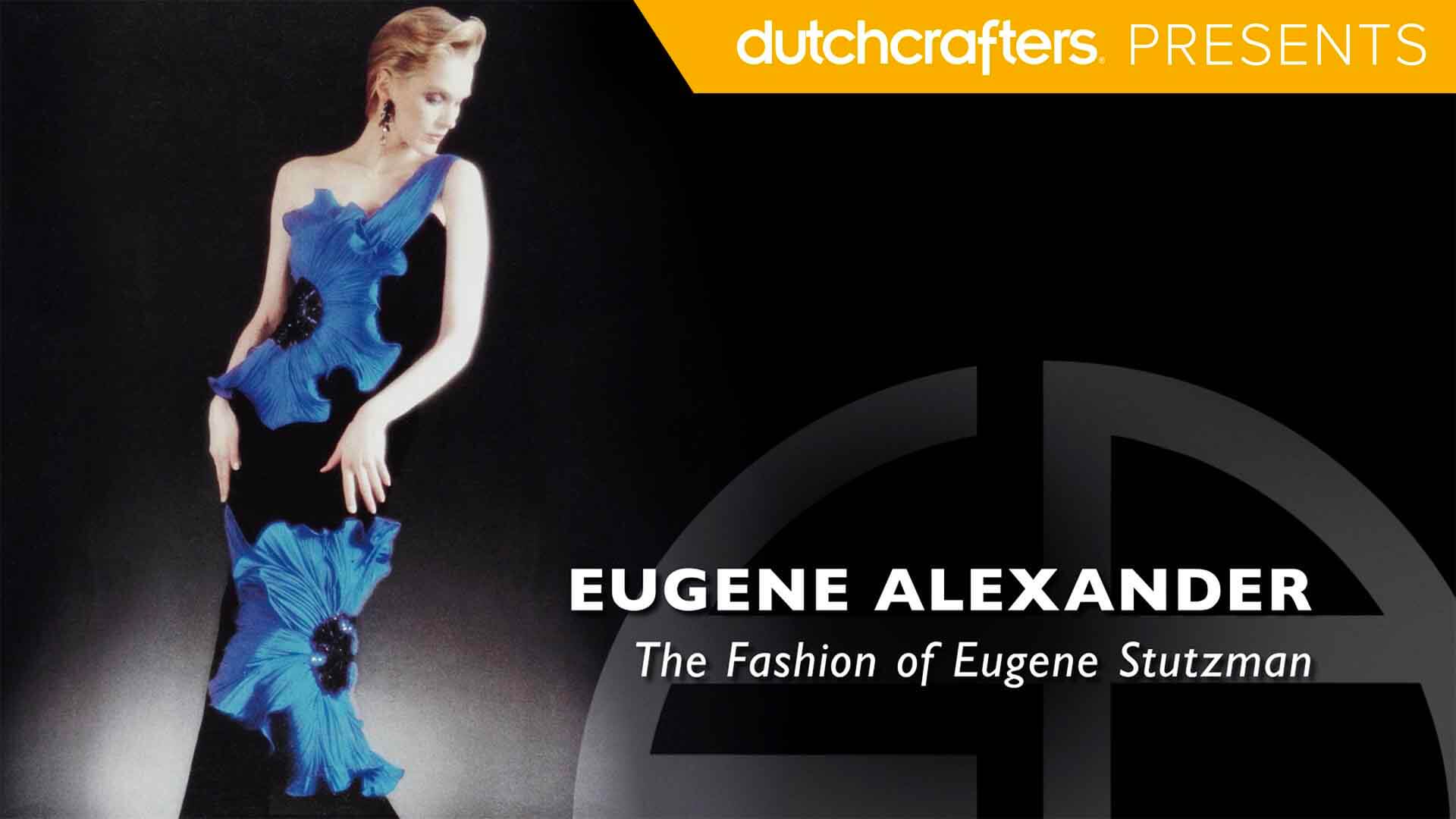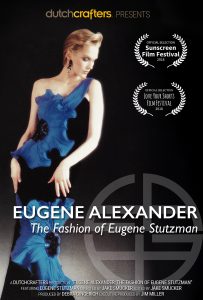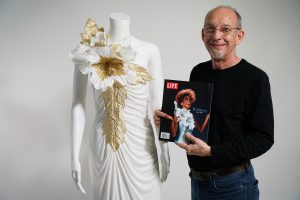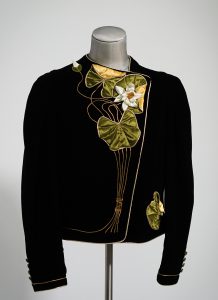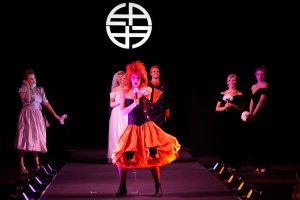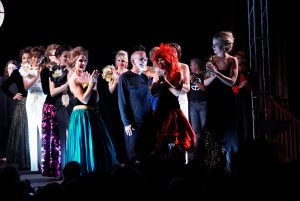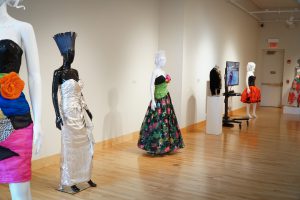

Eugene Alexander: The Fashion of Eugene Stutzman is a 15-minute documentary that was an Official Selection to both the Sunscreen Film Festival and Love Your Shorts Film Festival in 2018. It is now available in its entirety right here on dutchcrafters.com.
- Movie Poster for Eugene Alexander: The Fashion of Eugene Stutzman
- Whitney Houston is memorialized in a Life magazine cover wearing a Eugene Alexander dress. Original photoshoot for Time magazine in 1986.
- The design that started it all: the water lily jacket, by Eugene Alexander in 1982.
The film reveals the lasting impact of the couture dresses created by the fashion design team of Eugene Stutzman and Alexander Wallace in the 1980s and 1990s. Framed by a fashion show fundraiser for The Goshen Theater in Goshen, Ind. on September 23, 2017, the film explores Mennonite fashion designer Eugene Stutzman’s experiences dressing Hollywood customers, his dressmaking inventions used in his factory in Sarasota, Fla., his endeavors after leaving the fashion industry, and how his dresses have a second life through the Eugene Alexander Hope Foundation.
- A singer interrupts a wedding procession in a scene of the 2017 fashion show at Goshen Theater in Goshen, IN.
- Eugene, surrounded by the show’s models, receives a standing ovation after his fashion show at Goshen Theater in Goshen, IN
- 2018 Eugene Alexander Exhibit at Goshen College’s Abner Hershberger Art Gallery
Why Produce a Film?
Stutzman stepped beyond the constraints of Mennonite and Amish convention while also drawing upon that tradition for both his style aesthetic and manufacturing choices. Here at DutchCrafters, we believe in the value of quality craftsmanship and authenticity with the customer. Our company is founded on these Mennonite and Amish values; just as the fashion of Eugene Alexander continues to hold its value decades after creation, our furniture is built with a longevity that makes it a family heirloom. Jim Miller at DutchCrafters Amish Furniture saw the connection between Stutzman’s choices and the DutchCrafters brand and made it possible for Stutzman’s story to be told. We also think it’s just a great story. Enjoy.
Back to the DutchCrafters Video Page
Film Transcript:
Before the Show: The Goshen Theater, 2017
Eugene: For me it’s just an incredible feeling and I’m just thrilled to be having this experience now. This show at the Goshen Theater is the fifth show that the Eugene Alexander Hope Foundation is doing. We now have four hundred dresses and we make these dresses available to nonprofits as fundraising tools via a fashion show. These dresses are 30 years old now, so the dresses have this new life. Which I think is a nice testament to the quality of the dresses that they’ve lasted that long. So I’m very excited about this.
The Start of Eugene Alexander
I designed a small collection of dinner jackets and Alex took them to New York and it was very difficult to get in to see anyone so he went to, I guess, the Salvation Army or Goodwill on bought a brown shirt and brown pants so he looked like a UPS driver and he had this jacket in a box and he got into Bloomingdale’s opened the box pulled out the jacket and the buyer really loved the jacket.
That first season Alex came back from New York with well over 50,000 in orders so we set up our own factory, we hired people, I taught them how to make this three-dimensional embroidery, and we just started manufacturing here in Sarasota and we never quit. That first season this jacket was purchased by every major department store in the United States. They all said they had discovered us.
Alex and I had really terrific success in the fashion industry and I like to in my humble Mennonite way attribute that to the fact that we knew strong women: my sisters, my mother, college friends. We knew this customer—this 80s woman.
Eugene’s Early Life
Jim: Well, Eugene, thanks for taking the time to sit down with me. I’ve heard you talk about the influence of your mother. She was full of encouragement for you throughout your life, wasn’t she?
Eugene: Yes, she was, and she had a gender non-conforming little boy. She encouraged me to do the drawing projects and costume projects and things like that which she was ahead of her time. Goshen College played a major role in my life I was just naive guy from Holmes County. We had no TV. So, all of these things converged on me my freshman year: this, to me at the time, very sophisticated world of higher education that I was embracing totally. After graduating from Goshen, I attended Kent State University where I studied ceramics and sculpture and that’s where I met Alex. We connected immediately and that summer we fell in love and decided to move to Florida. Alex was, well, he looked like a movie star. I can brag about my husband. Well, he was a very handsome man.
Jim: And he had the personality that went with it.
Eugene: Yes, he did. That’s true. And he had his finger on the pulse of what’s going on and that’s one of the designer’s jobs is to observe and absorb what is happening in the culture. And then we would bring all of those things together and try and interpret it for our customer. We would meet these customers and they would tell us their stories and they would say what their occasion is, so we were we were dressing them for the special momentous occasions in their life and that really drove our design philosophy.
The Famous Dresses of Eugene Alexander
The word was out on Seventh Avenue that they young Whitney Houston was looking for a dress for a photo shoot for Time magazine and in walks Whitney Houston. Alex was there and he fitted her. I was watching The Cooking Channel one day and I saw this dress and I thought, ‘oh my god.’ The dress was in a commercial for the new movie Sex and the City.
This dress is probably the best example of the pleating technique that I invented which makes these radiating pleats on the petals which no one really has been able to replicate. The large floral trims became our signature look.
This is an example of one of Joan Rivers favorite dresses because she was co-hosting the Johnny Carson show and she was sitting behind a desk and Joan Rivers’ thing was ‘above the table.’ ‘Eugene, it has to be above the table.’
In the shop we always called this the Republican dress because during the Bush I inaugural there’s a famous picture in one of the Washington newspapers of five or six women at the inaugural ball and they’re all lined up like a little Chorus Line wearing this dress, ranging from size probably four to sixteen.
If you’re driving through Holmes County or Lancaster County, you’ll see these beautiful little Amish boys with these highly contrasting colors which I think has affected my design aesthetic as well. Alex and I finally acknowledged the Amish influences in our collection and we called it the Amish quilt collection. When I get one of my 30-year-old dresses back that I buy on eBay it’s amazing when I see how beautifully finished they were inside and out, and that goes back to this integrity issue I believe. And I think that’s an Amish characteristic.
Crafted with Pride in the USA
Jim: While a lot of your competitors were having their dresses made in Vietnam or China or other places, you chose to have your dresses made right here in the United States.
Eugene: We chose to do that because the nature of our product depended on techniques and devices that I had actually invented—pleating and that kind of thing—but we also wanted to have very tight control over the quality and the only way to do that was to have it done here in the United States. We were the first evening wear designer that qualified to put the crafted with pride in the USA label in our merchandise. It was the ethical dilemma that many designers faced in having their garments made offshore. They knew the conditions. They knew the very, very low wages that were paid. We didn’t live with that. We had very happy workforce, paid well with benefits here in Sarasota.
Life After Eugene Alexander
Alex and I decided to close our business in 1993. It was really no fun anymore. We were being knocked off. The stores, the specialty stores across the country were merging or being forced out of business.
Bipolar disorder is something that Alex struggled with all of his life and the bipolar disorder mood swings affected him much more acutely after we closed our business and would go into the really deep depression and it ended very sadly in him taking his own life in 2005. In 2005 my mother died, Alex died, and in February of 2006 my father died. So all of a sudden all three of these people were gone, my caregiving jobs were all gone.
I wanted to do something completely different and so I returned to the pipe organ, which had been my passion in college—my senior show. Behind this is a huge bank of speakers, so I build pipe facades that conceal the speakers. Like my dresses brought a visual impact to special occasions, that’s what my pipe organs are doing too—it’s very good feeling.
The Legacy of Eugene Alexander
Alex and I were great champions of social justice issues during the 80s and 90s. One of the things we were most passionate about was AIDS research as well as children’s charities, abused women, so when Alex died, my friend Sue Kaufman and I formed the Eugene Alexander Hope Foundation as a way of continuing the work that we had done. Preparing for the Goshen show is kind of bringing this all back and a really lovely nostalgic way for me.
Jim: Alex would be proud of this moment.
Eugene: He would be. He would be really proud of this moment.


